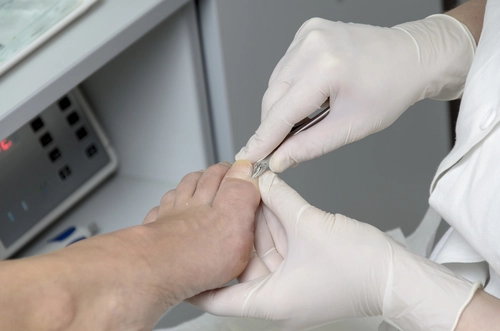Internal Medicine Coding Alert
Medicare Covers Foot Exams for Diabetics With LOPS

Medicare will now pay for regular foot examinations for diabetic patients who have been diagnosed with peripheral neuropathy with loss of protective sensation (LOPS). Code these exams using a new series G0245, G0246 and G0247.
Peripheral neuropathy with LOPS, one of the many complications that can result from diabetes mellitus, is the most common reason for amputation in diabetic patients.
Some primary-care physicians provide routine foot care to their patients and will use these new codes in their practices. However, even the many internists who refer their diabetic patients out to podiatrists for specialized foot care need to be aware of the new codes, which went into effect July 1, and the rules for using them. For example, Jerome S. Fischer, MD, a board-certified internist and endocrinologist at Diabetes and Glandular Disease Clinic in San Antonio and the author of Diabetes Care Documentation and Coding for Clinicians, published in 2002 by the American Diabetes Association, says he will continue to examine his patient's feet regularly but will include that examination in his E/M coding , allowing the podiatrists who provide his patients with specialized foot care to use the new codes.
Medicare will pay for the foot exams only for diabetic patients who have a documented diagnosis of peripheral neuropathy with LOPS, diagnosed through sensory testing with the Semmes-Weinstein monofilament using established guidelines. Beard says physician offices that do not now do this testing can purchase the proper equipment for about $250.
The new codes are:
3. A physical examination including at least the following: Visual inspection of the forefoot, hindfoot, and toe web spaces, Evaluation of a protective sensation, Evaluation of foot structure and biomechanics, Evaluation of vascular status and skin integrity, Evaluation and recommendation of footwear.
2. A physical examination that includes:
Visual inspection of the forefoot, hindfoot, and toe web spaces, Evaluation of protective sensation, Evaluation of foot structure and biomechanics, Evaluation of vascular status and skin integrity, Evaluation and recommendation of footwear.
3. Patient education.
Use G0245 for the visit resulting in the initial diagnosis of LOPS. G0246 is used for a follow-up visit. G0247 cannot be billed by itself but must be coded on the same date of service as either G0245 or G0246.
Medicare will pay for G0246 every six months with one caveat: The patient cannot have seen a foot specialist for any other problem during that period.
Acceptable Diagnosis Codes
Be sure to use the proper diagnosis code in the 250.6x series (Diabetes mellitus with neurological manifestations) and 357.2 (Polyneuropathy in diabetes) or your claim may be denied.
Medicare's decision to cover foot exams every six months for these patients recognizes that detecting and treating this disease early can stave off devastating complications for the patient and expensive healthcare bills for payers, says Karen M. Beard, CPC, a senior associate at Medical Management Associates Inc., in Atlanta. "I think this is an effort to get more people who have access to patients with diabetes to pay careful attention to the patients' feet because of the potential for major complications," Beard says.
The rules for using the new codes were announced in April in Transmittal AB-02-042, then updated in July and August with further information and to clarify that the codes are intended for use by physicians in evaluating and managing disease. Visit your local Medicare carrier's Web site for the local medical review policies on these codes.
1. The diagnosis of LOPS.
2. A patient history.
4. Patient education.
1. A patient history.
1. Local care of superficial wounds,
2. Debridement of corns and calluses, and
3. Trimming and debridement of nails.
Internal Medicine Coding Alert
- CPT:
You CAN Go Home Again (to the Patient's Home,That Is) and Get Paid
House calls may not be as common as they were a century ago, but Medicare [...] - ICD-9:
Don't Let Your Diabetes Coding Get Out of Control
Diagnosis coding for diabetes may seem straightforward, but even experienced coders can get tripped up [...] - You Be the Coder:
Modifiers With Joint Injections
Test your coding knowledge. Determine how you would code this situation before looking at the [...] - Get Paid for Prolonged Home Visits
When patients require longer-than-normal physician visits, you can use prolonged services codes 99354-99357 with the [...] - Rule Out Other Types of Diabetes
Coders need to pay special attention to information recorded in the chart to ensure that [...] - News Brief:
Medicare Covers Foot Exams for Diabetics With LOPS
Medicare will now pay for regular foot examinations for diabetic patients who have been diagnosed [...] - Reader Question:
Repeat Treatment of Wart
Question: A physician's assistant in the office saw a patient for a plantar wart. The [...] - Reader Question:
Discharge of Dead Patients
Question: The local nursing home sent me notification to go there and complete charts on [...] - Reader Question:
Hospital Versus Outpatient Code
Question: We sent a patient to the hospital to have a blood transfusion, and then [...] - Statement of Ownership, Management, and Circulation

